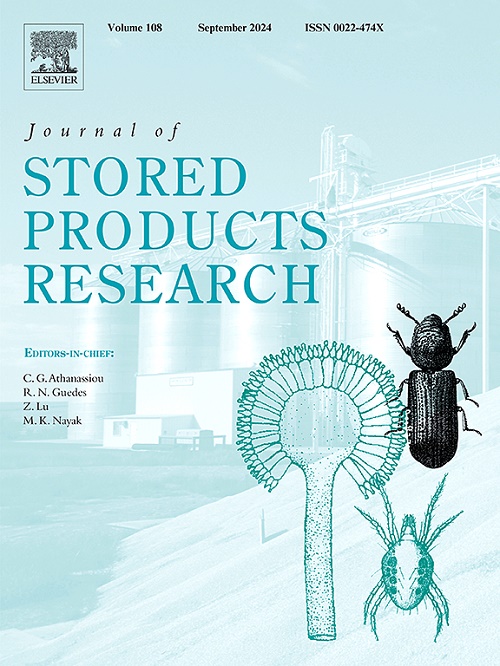Application of synchrotron imaging techniques for study of changes in microstructural and nutritional properties of different wheat classes in storage
IF 2.7
2区 农林科学
Q1 ENTOMOLOGY
引用次数: 0
Abstract
Preserving the quality and integrity of wheat during storage is crucial for food security and industry applications. Eight wheat varieties of different classes were stored for 8 weeks at 17% moisture content (wet basis) before data acquisition using synchrotron phase contrast micro tomography, synchrotron X-ray fluorescence imaging, and mid-IR spectroscopy at the Canadian Light Source, Saskatoon, Canada. Differentiation of wheat is possible based on changes in the microstructure of selected wheat classes. Minimum changes in microstructure were observed in Canada Western Extra Strong (CWES), Canada Northern Hard Red (CNHR), Canada Western Red Winter (CWRW), Canada Western Special Purpose (CWSP), and Canada Prairie Spring White (CPSW) classes of wheat, suggesting that these could perform better in storage. The existing condition of kernel microstructure strongly influences the performance of wheat in storage, which is a significant outcome of this study. The micronutrients distribution and biochemical composition were affected at the end of 8 weeks of storage in deteriorated wheat classes Canada Prairie Spring Red (CPSR), Canada Western Hard White Spring (CWHWS), Canada Western Soft White Spring (CWSWS), and Canada Western Extra Strong (CWES). Data could also help plant breeders to develop varieties that do not spoil easily, improve grain processing techniques, and develop post-harvest recommendations.
应用同步加速器成像技术研究不同小麦品种贮藏过程中显微结构和营养特性的变化
在储存期间保持小麦的质量和完整性对粮食安全和工业应用至关重要。8个不同类别的小麦品种在17%含水量(湿基)下储存8周,然后在加拿大萨斯卡通的加拿大光源使用同步加速器相衬显微断层扫描、同步加速器x射线荧光成像和中红外光谱进行数据采集。根据所选小麦类别的微观结构变化,小麦的分化是可能的。加拿大西部特强小麦(CWES)、加拿大北方硬红小麦(CNHR)、加拿大西部冬红小麦(CWRW)、加拿大西部特殊用途小麦(CWSP)和加拿大草原春白小麦(CPSW)的微观结构变化最小,表明这些小麦的贮藏性能更好。小麦籽粒微观结构的存在状况对贮藏性能有重要影响,是本研究的重要成果。变质小麦品种加拿大草原春红(CPSR)、加拿大西部硬白春(CWHWS)、加拿大西部软白春(CWSWS)和加拿大西部特强(CWES)贮藏8周后微量元素分布和生化组成受到影响。数据还可以帮助植物育种者开发不易腐烂的品种,改进谷物加工技术,并制定收获后建议。
本文章由计算机程序翻译,如有差异,请以英文原文为准。
求助全文
约1分钟内获得全文
求助全文
来源期刊
CiteScore
5.70
自引率
18.50%
发文量
112
审稿时长
45 days
期刊介绍:
The Journal of Stored Products Research provides an international medium for the publication of both reviews and original results from laboratory and field studies on the preservation and safety of stored products, notably food stocks, covering storage-related problems from the producer through the supply chain to the consumer. Stored products are characterised by having relatively low moisture content and include raw and semi-processed foods, animal feedstuffs, and a range of other durable items, including materials such as clothing or museum artefacts.

 求助内容:
求助内容: 应助结果提醒方式:
应助结果提醒方式:


